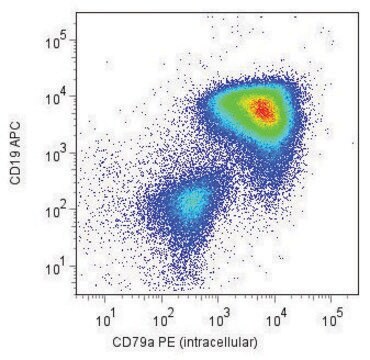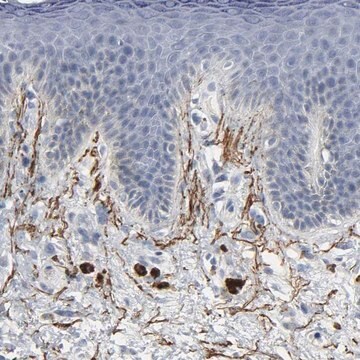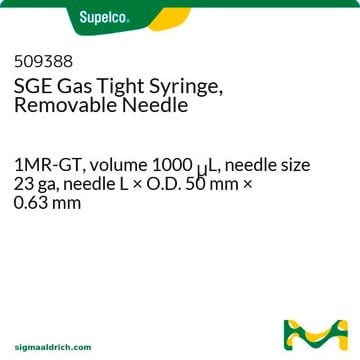General description
We are committed to bringing you greener alternative products, which adhere to one or more of The 12 Principles of Green Chemistry. This antibody is Preservative-free, produced without the harm or sacrifice of animals and exceptionally stable to allow for ambient shipping and storage if needed and thus aligns with "Waste Prevention", "Designing Safer Chemicals" and "Design for Energy Efficiency".
Click here for more information.
ZooMAb® antibodies represent an entirely new generation of recombinant monoclonal antibodies. Each ZooMAb® antibody is manufactured using our proprietary recombinant expression system, purified to homogeneity, and precisely dispensed to produce robust and highly reproducible lot-to-lot consistency. Only top-performing clones are released for use by researchers. Each antibody is validated for high specificity and affinity across multiple applications, including its most commonly used application. ZooMAb® antibodies are reliably available and ready to ship when you need them.
Specificity
Clone LeoA1 is a ZooMAb® mouse recombinant monoclonal antibody that specifically detects CD226/DNAM-1.
Application
Quality Control Testing
Evaluated by Immunocytochemistry in Chinese hamster ovary (CHO) cells transfected with human CD226.
Immunocytochemistry Analysis: A 1:1,000 dilution of this antibody detected CD226/DNAM-1 in Chinese hamster ovary (CHO) cells transfected with human CD226. expression.
Tested Applications
Flow Cytometry Analysis: 1 µg from a representative lot detected CD226/DNAM-1 in one million Human peripheral blood mononuclear cells (PBMC).
ELISA Analysis: A serial of dilutions from a representative lot detected recombinant Human CD226/DNAM-1.
Note: Actual optimal working dilutions must be determined by end user as specimens, and experimental conditions may vary with the end user.
Target description
CD226 antigen (UniProt: Q15762; also known as DNAX accessory molecule 1, DNAM-1, CD226) is encoded by the CD226 (also known as DNAM1) gene (Gene ID: 10666) in human. CD226, a single-pass type I membrane protein of the immunoglobulin superfamily, is synthesized with a signal peptide (aa 1-18), which is subsequently cleaved off to produce the mature protein that contains an extracellular domain (aa 19-254), a transmembrane domain (aa 255-275), and a cytoplasmic domain (aa 276-336). It also contains two Ig-like C2 type domains (aa 19-126 and 135-239). CD226 is expressed in T cells, NK cells, NK T cells, B cells, monocyte/macrophage, and dendritic cells. It is involved in cytotoxicity and cytokine secretion of T cells and NK cells and in platelet aggregation and activation. It serves as a receptor involved in intercellular adhesion and lymphocyte signaling. It promotes the migration, activation, proliferation, differentiation, and function of CD8 + T cells. CD155 and CD112 have been recognized as ligands for CD226. Solid tumor and hematological malignancies that express high levels of CD155 and CD112 are attractive targets for CTL attack via CD226-specific binding. CD226 expression is negatively correlated with the inhibitory function of Foxp3 + Tregs. TIGIT, a co-inhibitory molecule on T cells, is shown to exert immunosuppressive effects by competing with CD226 for the CD155 ligand. Clone LeoA1 is reported to upregulate IL-10 production in human PBMC and promotes the differentiation of CD4+ IL-10+ T cells. It inhibits the production of Th1/Th17 related genes and cytokines while promotes iTreg associated ones in human CD4+ T cells. This ZooMAb® recombinant monoclonal antibody, generated by our propriety technology, offers significantly enhanced specificity, affinity, reproducibility, and stability over conventional monoclonals. (Ref.: Huang, Z., et al. (2020). Front. Cell Dev. Biol. 8; 564; Zhang, R., et al. (2016). Oncotarget. 7(15); 19251-19264; Xu, Z., et al. (2009). BMC Immunology 10; 34; Shibuya, A., et al. (1996). Immunity: 4(6); 573-581).
Physical form
Purified recombinant mouse monoclonal antibody IgG, lyophilized in PBS, 5% Trehalose, normal appearance a coarse or translucent resin. The PBS/trehalose components in the ZooMAb formulation can have the appearance of a semi-solid (bead like gel) after lyophilization. This is a normal phenomenon. Please follow the recommended reconstitution procedure in the data sheet to dissolve the semi-solid, bead-like, gel-appearing material. The resulting antibody solution is completely stable and functional as proven by full functional testing. Contains no biocide or preservatives, such as azide, or any animal by-products. Larger pack sizes provided as multiples of 25 µL.
Reconstitution
0.3 mg/mL after reconstitution at 25 µL per vial. Please refer to guidance on suggested starting dilutions and/or titers per application and sample type.
Storage and Stability
Recommend storage of lyophilized product at 2-8°C; Before reconstitution, micro-centrifuge vials briefly to spin down material to bottom of the vial; Reconstitute each vial by adding 25 µL of filtered lab grade water or PBS; Reconstituted antibodies can be stored at 2-8°C, or -20°C for long term storage. Avoid repeated freeze-thaws.
Other Notes
Concentration: Please refer to the Certificate of Analysis for the lot-specific concentration.
Legal Information
ZooMAb is a registered trademark of Merck KGaA, Darmstadt, Germany
Disclaimer
Unless otherwise stated in our catalog or other company documentation accompanying the product(s), our products are intended for research use only and are not to be used for any other purpose, which includes but is not limited to, unauthorized commercial uses, in vitro diagnostic uses, ex vivo or in vivo therapeutic uses or any type of consumption or application to humans or animals.










